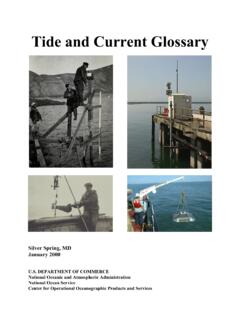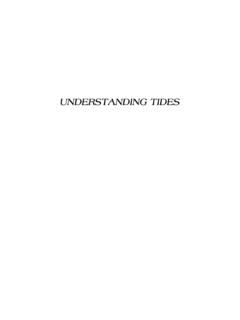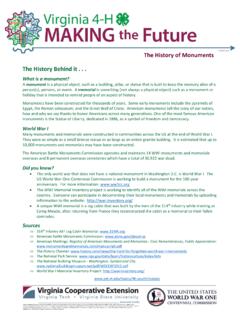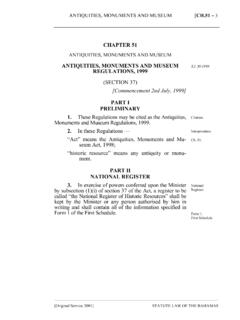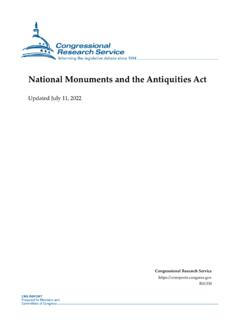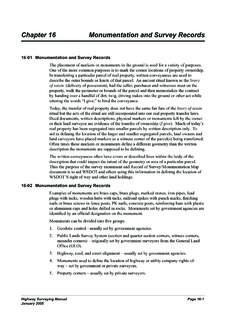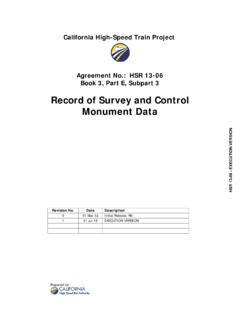Transcription of ATTACHMENT V SETTING AN NGS 3D MONUMENT
1 Updated Oct. 27, 2009 September 30, 2004 ATTACHMENT V SETTING AN NGS 3D MONUMENT TO SCOPE OF WORK FOR SHORELINE MAPPING UNDER THE NOAA COASTAL MAPPING PROGRAM REMOTE SENSING DIVISION NATIONAL GEODETIC SURVEY NATIONAL OCEAN SERVICE NATIONAL OCEANIC & ATMOSPHERIC ADMINISTRATION DEPARTMENT OF COMMERCE V Page 2 TABLE OF CONTENTS ATTACHMENT V: SETTING AN NGS 3-D MONUMENT PAGE 1. 3 2. 3 3. 4 4. 4 RECOMMENDED EQUIPMENT FOR SETTING 4 MATERIALS REQUIRED FOR EACH 5 SETTING 6 ANNEX 1: DIAGRAM OF AN NGS 3-D ROD 9 V Page 3 ATTACHMENT V: SETTING AN NGS 3-D MONUMENT Based on "Revised NGS 3-Dimensional (3-D) Rod Mark" [Draft Version] by: Curtis L.
2 Smith National Geodetic Survey July, 1996 1. DISCLAIMER This document is intended only for the purpose of providing the user with guidelines for planning and implementation of this style of survey MONUMENT . The distribution of this document or the mention of a commercial company or product contained herein does not constitute, in any way, an endorsement by the National Geodetic Survey (NGS). 2. INTRODUCTION The extensive use and accuracies achieved by the Global Positioning System (GPS) for geodetic surveying applications have highlighted the need for increased stability in survey control point monumentation.
3 Repeatability of accurate positions obtained through GPS requires that geodetic monuments reflect this accuracy with properties of permanence and stability both horizontally and vertically. Factors affecting the stability of survey monuments include frost heave action, changes in ground water levels, and local settlement. Consult soil and geotechnical specialists about local ground conditions. Manuals, such as NOAA Manual NOS NGS 1, Geodetic Bench Marks ( ), document soil types and frost penetration zones nationwide. The recommended survey marker that produces stability for most conditions is the three-dimensional (3-D) drivable survey MONUMENT .
4 The principal component of this MONUMENT is a 9/16-inch stainless steel rod driven into the ground, utilizing a gasoline powered reciprocating hammer, until refusal or a reduced driving rate has been achieved. The rounded top of the rod is the survey datum point. The upper 1 meter of the rod is encased in a 1-inch greased filled plastic extruded fin sleeve that is held horizontally stable by back-filled, washed sand. The effects of up and down ground movement during freeze/thaw or wet/dry conditions are removed from the anchored rod by the grease filled sleeve promoting vertical stability. A 5 or 6-inch PolyVinyl Chloride (PVC) pipe with attached, standard, NGS aluminum logo cap protects and identifies the top of the MONUMENT .
5 (See documentation in this manual for specific mark SETTING procedures). V Page 43. REFERENCES NOAA Manual NOS NGS 1. Geodetic Bench Marks, by Floyd, Richard P., September 1978, see: . Geometric Geodetic Accuracy Standards and Specifications for Using GPS Relative Positioning Techniques, by Federal Geodetic Control Committee, August 1989, see: . 4. REQUIREMENTS RECOMMENDED EQUIPMENT FOR SETTING MONUMENTS A. Rod Drivers and Accessories: Safety Goggles for each worker. 1- Any driver with a minimum impact force of 25 foot pounds per blow, such as the Wacker Model BHB 25 (with tool kit) or Pionjar Model 120 (with tool kit), for driving stainless steel rods.
6 1- Rod Driving Insert, holds machine on rod and acts as impact point while driving rods. 1- Shovel Bit, for machine to help start and dig holes, not required but may be helpful. 1- Pint, Required Oil Type and Calibrated Container, for determining gas/oil mix. 2- Gas Containers and Gasoline, for driving machine and generator. B. Digging the Hole: 1- Post Hole Digger, capable of digging a hole 4-feet deep. 1- Gas Powered post Hole Digger with Augurs, not required but increases productivity. 1- Digging Bar, for rocks and hard to dig holes. C. Driving the Rod: 1- 2 lb. Hammer, to start rods, stamp designations, etc.
7 2- 8" Quality Pipe Wrenches ( Rigid), for attaching lengths of stainless steel rods. 1- Bottle, Loctite, for cementing threads on the stainless steel rods. D. Finishing the Rod: 1- Hack Saw with extra quality Blades, for cutting stainless steel rod. 1- 4" or 5" Grinder (electric or battery powered), for finishing top of rod. 1- Gas Powered Electric Generator, to power grinder and/or drill. 2- Sanding Disks (medium grade), for grinder. 1- Steel File(s), for fine finishing top of rod. 1- Centering Sleeve, to help center punch mark on top of rod. 1- Center Punch, to punch plumbing point on top center of rod. Assorted Sand Paper or Sanding Pad, for fine finish to top of rod.
8 E. Finishing the MONUMENT : V Page 51- 1/4-inch Stamping Set, for lettering and numbering station designation/date on Logo Cap. 1- Hand Saw, for cutting 5 or 6-inch PVC pipe. 1 - Bucket or Wheel Barrel, to mix cement/move unwanted dirt. 2- Five Gallon Water containers and clean Water, to mix cement and clean equipment. 1- Hoe, to mix cement, can be replaced by Sharp Shooter Shovel . 1- Heavy Rubber Mallet, to help lower logo cap/5-inch PVC into cement. 1- Cement Finishing Trowel, to smooth top of concrete for neat appearance. 1- Stiff Vegetable Type Brush, to clean logo cap and hinges. F. Assorted Accessories: 1- Tool Box with regular assortment of tools, for incidental repairs: slotted and Phillips Head Screw-Drivers, Pliers, Needle Nose Pliers, Wire Cutters, Assorted Wrenches, Sockets, Socket-Wrench, Allen Wrenches, Wire Brush.
9 1- Round Nose Shovel, to help dig hole and move unwanted dirt. 1- Tile Spade ( Sharp Shooter Shovel ), to help dig hole and mix cement. 1- Roll Black Tar Paper (Felt Paper) or cardboard form, for making a round form for top of MONUMENT . 1- 30 Meter Tape Measure, for distances in station description. Leather or Cotton Gloves, Assorted Rags or Paper Towels. MATERIALS REQUIRED FOR EACH MARK Sufficient lengths of 9/16-inch diameter Stainless Steel Rods, 4-foot sections. 1- Four to five-inch piece of Stainless Steel Rod, used as impact point and protection while driving rods. Adequate supply of 3/8-inch Threaded Stainless Steel Studs.
10 1- Steel Spiral (fluted) Rod Entry Point, standard order. 1- Aluminum Logo Cap, standard order. 1- Schedule 40 PVC Pipe, 5 or 6-inch diameter, 24-inch length. 1- Plastic Extruded Fin sleeve, 1-inch diameter, 3-feet minimum length. 2- Plastic end Cap Alignment Bushings, center drilled to 9/16-inch (for extruded fin sleeve). 1- Pint, PVC cement, can be replaced with adequate Epoxy type. 1- Pint, PVC Cleaning Solvent, when using PVC cement. 1- 17 ounce tube, Non-Toxic, Food Grade Grease, with Applicator ( grease gun). Ready Mix Concrete (Amount depends on width and depth of hole). 2- Pounds, Portland Cement, added to enhance integrity of ready mix concrete if necessary.

